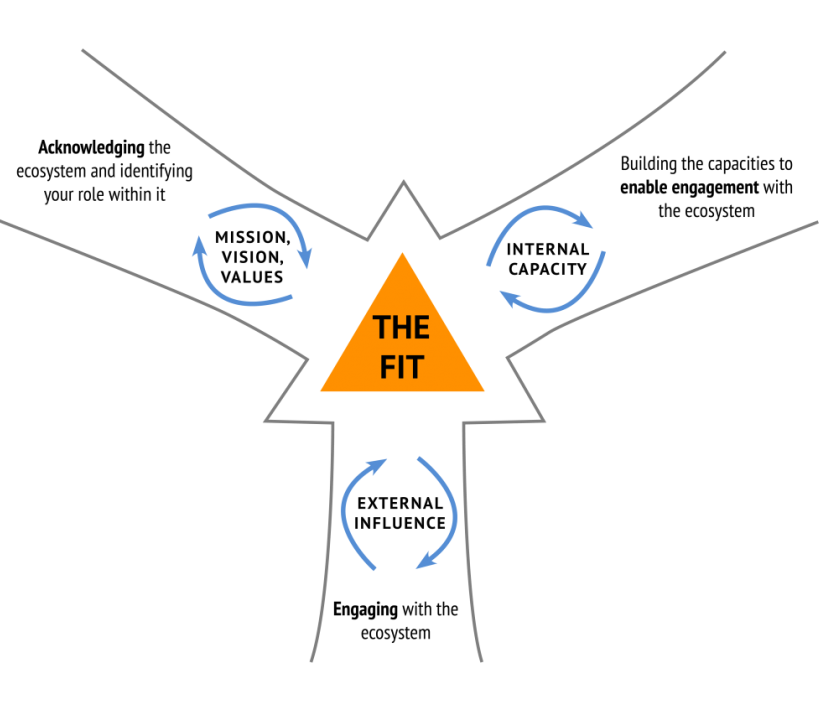 Using an Ecosystem Approach to Define Nonprofit Strategy
Using an Ecosystem Approach to Define Nonprofit Strategy
by Bonnie Mazza, Associate Director of Nonprofit Strategy & Capacity Building, TCC Group
We know many foundations are actively encouraging their grantees to scale their efforts and collaborate with others. We hear constantly, on area panels and elsewhere, stories of grantees submitting competing proposals, aiming to achieve outcomes that would be better realized if they were to be working collaboratively with one another. An ecosystem framework helps organizations think about just that—the necessity to leverage one another and work together, and the capacities necessary to work in relation to others in order to maximize impact.
At TCC, my colleagues and I have been considering how we can infuse the ecosystem more explicitly into our nonprofit strategy services. First, we have revisited a few core concepts and considered a shift in how we examine an organization’s vision and mission; core capacities; and external environmental influences in the development of strategic programmatic goals—something many of us in the planning business have traditionally referred to as “the Fit” framework (right).
In partnering with our nonprofit clients, we have begun to encourage them to consider their organization in active relationship to the ecosystem. Rather than identifying gaps and needs in the external environment and then independently aiming to fill them, organizations today are better off considering a more “relational” stance—actively examining what their role is, can, or should be—in influencing the external environment; how can they work with others to achieve results? Questions we tend to ask in this process include: “Who shares your vision?” “What is your unique role in the ecosystem” “What is your role in building shared value?” among others.
While we believe all organizations can benefit from taking an “ecosystem approach” to planning, we have found this to be especially relevant for nonprofits pursuing strategic planning with hopes of increasing their impact (e.g., they are not “broken” or needing to repair the organization; they are not planning for planning’s sake – “our last plan expired” – but have reached a place where they seek pathways to scale or grow their impact). Many of these groups are what we would call “hybrid organizations”: they deliver direct services (or provide services to other organizations), as well as influencing policy or affecting larger societal change. Frequently, we find that each of these approaches to their work remain critical and provide credibility to the other. Additionally, these organizations are not necessarily overhauling their programming; rather, they are seeking to recalibrate their roles in each of their core service areas, asking the questions: “Are there others to whom we might pass the baton in this area?” “How can we best leverage our core competencies to continue advancing this objective?” “At which decision-making tables should we make sure we’re sitting?” “In what areas do we lead versus support—where are we a hub, spoke, or a node—and what are the implications of this positioning?”
Organizations embracing an ecosystem approach to planning begin to answer such questions by re-envisioning “The Fit” framework with the following modifications to the traditional strategic planning Venn diagram:

TCC has experiences overlayering an acknowledgement of the ecosystem and the definition of an organization’s role within it onto the traditional first step of the planning process – the affirmation of a nonprofit’s mission, vision, and values.
We continue to define a societal vision as “the change you seek to see in the world—the ultimate impact towards which you are striving.” It is relatively uncommon for a nonprofit engaged in strategic planning to intentionally consider its role in relation to the other social sector actors essential to the realization of its long-term vision. We encourage our nonprofit partners to remember that solutions for complex social sector problems are not derived from the work of one organization alone. Increasingly, there is agreement that, it will not only take more than the commitment and labor of any single organization; it will likely take more than a single sector to realize the desired change. As TCC Group adopts an ecosystem approach to its strategic planning work, we are placing greater emphasis on collaboration, cross-sector partnerships, and building an understanding of “the ecosystem,” in service to this belief.
Once a somewhat self-referential narrative, the definition of a nonprofit’s vision, and most importantly, its mission—or the unique role it plays in helping to achieve the vision—must now be considered within a larger context. Only by clarifying mission and vision within a web of fellow social sector actors can an organization determine its short-term outcomes, i.e., the metrics by which it will ultimately determine its strategic plan’s success, and for which it will be directly accountable.
